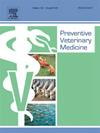Efficacy of continuous education and determinants of antimicrobials prescription behavior in companion animal veterinarians from Quebec, Canada
IF 2.4
2区 农林科学
Q1 VETERINARY SCIENCES
引用次数: 0
Abstract
Highly important antimicrobial use in veterinary companion animal medicine is frequent and in some cases unjustified. Establishing cautious and evidence-based prescription practices in veterinary companion animal medicine should be one of the key objectives of One Health antimicrobial stewardship initiatives. We aimed to (1) develop a training program on antimicrobial use in veterinary companion animal medicine in Quebec, Canada, (2) quantify the impact of this training on the use of highly important antimicrobials, and (3) identify the factors that could limit such an impact. A total of 54 veterinarians from 35 veterinary facilities participated in the study. Antimicrobials were identified from electronic medical records, prescription rates were calculated and a difference-in-differences estimation was used to compare prescription rates pre- and post-training in 2023, controlling for seasonal trends during the same period in 2022. Participating veterinarians prescribed on average 11.7 antimicrobial treatments per 100 consultations. Two thirds of the systemic antimicrobials prescribed by participants were antimicrobials of very high medical importance, according to Health Canada. Amoxicillin-clavulanic acid was the most often prescribed antimicrobial and accounted for approximately 22 % of all prescriptions. The training had a limited impact on overall prescription rates. However, a reduction of 55 % in prescription rate was observed for metronidazole, which is most often prescribed in canine patients with acute diarrhea. Interviews were conducted with 11 participating veterinarians to identify obstacles to the implementation of recommended prescription practices. The main obstacles identified were pet owner expectations, fear of therapeutic failure, lack of confidence in the recommendations and unavailability of therapeutic alternatives.
加拿大魁北克省伴侣动物兽医继续教育的效果及抗菌药物处方行为的决定因素
兽医伴侣动物用药中非常重要的抗菌药物的使用是频繁的,在某些情况下是不合理的。在兽医伴侣动物用药中建立谨慎的循证处方做法应成为“同一个健康”抗菌剂管理倡议的关键目标之一。我们的目标是(1)在加拿大魁北克省制定一项关于兽医伴侣动物药物抗菌药物使用的培训计划,(2)量化该培训对高度重要的抗菌药物使用的影响,以及(3)确定可能限制这种影响的因素。共有来自35家兽医机构的54名兽医参与了这项研究。从电子医疗记录中确定抗微生物药物,计算处方率,并使用差中差估计来比较2023年培训前后的处方率,同时控制2022年同期的季节性趋势。参与的兽医每100次咨询平均开出11.7种抗菌药物。根据加拿大卫生部的数据,参与者开出的全身抗菌剂中有三分之二是具有非常高医学重要性的抗菌剂。阿莫西林-克拉维酸是最常用的抗菌药物,约占所有处方的22% %。培训对总体处方率的影响有限。然而,甲硝唑的处方率降低了55% %,甲硝唑最常用于犬类急性腹泻患者。对11名参与调查的兽医进行了访谈,以确定实施推荐处方的障碍。确定的主要障碍是宠物主人的期望,对治疗失败的恐惧,对建议缺乏信心以及无法获得治疗替代方案。
本文章由计算机程序翻译,如有差异,请以英文原文为准。
求助全文
约1分钟内获得全文
求助全文
来源期刊

Preventive veterinary medicine
农林科学-兽医学
CiteScore
5.60
自引率
7.70%
发文量
184
审稿时长
3 months
期刊介绍:
Preventive Veterinary Medicine is one of the leading international resources for scientific reports on animal health programs and preventive veterinary medicine. The journal follows the guidelines for standardizing and strengthening the reporting of biomedical research which are available from the CONSORT, MOOSE, PRISMA, REFLECT, STARD, and STROBE statements. The journal focuses on:
Epidemiology of health events relevant to domestic and wild animals;
Economic impacts of epidemic and endemic animal and zoonotic diseases;
Latest methods and approaches in veterinary epidemiology;
Disease and infection control or eradication measures;
The "One Health" concept and the relationships between veterinary medicine, human health, animal-production systems, and the environment;
Development of new techniques in surveillance systems and diagnosis;
Evaluation and control of diseases in animal populations.
 求助内容:
求助内容: 应助结果提醒方式:
应助结果提醒方式:


